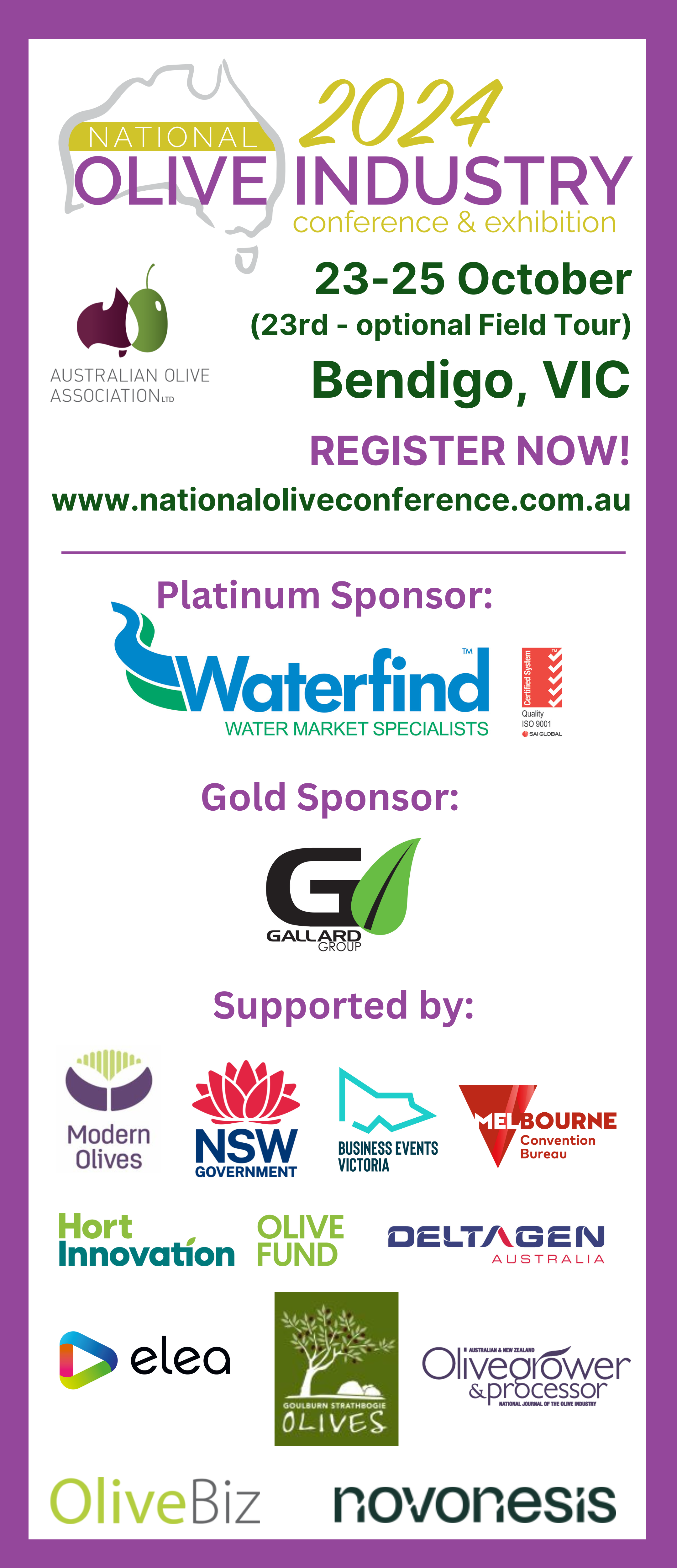Payments of the olives levy for the 2020 harvest were due by late October, so it’s time for all potential levy payers to check that they’ve met their obligations.
Collected by processors on behalf of the Department of Agriculture, Water and the Environment (DAWE), the levy is payable on olives that are produced in Australia and sold by a producer or used by the producer in the production of other goods. The levy rate is calculated per tonne of olive fruit.
Levy liability
The department has recently re-confirmed the circumstances for liability to make it crystal clear who is obliged to pay the levy:
A producer of olives, the person who grows the olives, is liable to pay the levy.
This may occur directly or indirectly, via one of the following channels:
- If you produce olives and sell your olives by retail sale, and the total quantity that you have sold between 1 October and 30 September in the next year is equal to or greater than $100 of levy, you must lodge a return and make a payment to the department.
- If you produce olives and sell your produce through an intermediary, including a first purchaser, buying agent or selling agent, the amount of levy they pay to the department on your behalf can be recovered from you by offset or otherwise.
- If you are an intermediary, including a first purchaser, buying agent, selling agent or a processor, you must lodge a return and make a payment to the department. You can recover from the producer the amount of levy paid to the department, by offset or otherwise.
Note: the term toll processor is sometimes used to describe a person or business that processes olives to make olive oil for other olive producers.
Are there exemptions?
Yes. The levy is not payable if a producer sells olives by retail sale or processes them into olive oil or table olives where the total amount of levy liability in the levy year would be less than $100.
However, this exemption does not apply to olives that are processed by someone other than the producer of the olives – i.e. if you send your fruit to a contract processor.
All fruit processed on behalf of others, no matter what the tonnage, is liable for the levy.
The following scenarios provide a simple explanation of the circumstances in relation to processors. Notes: the figures used are for illustrative purposes only; the $100 annual threshold equates to approximately 32.25 tonnes.
- Processor processes 30 tonnes of own olives into oil = exempt.
- Processor processes 30 tonnes of olives received from others but none of their own olives = a return for 30 tonnes of olives is required.
- Processor processes 30 tonnes of own olives and 5 tonnes of olives received from others = a return for 5 tonnes (covering olives received from others) is required. Own olives are exempt.
- Processor processes 35 tonnes of own olives and 35 tonnes of olives received from others = a return for 70 tonnes of olives is required.
Return and payment dates
The olives levy year begins on 1 October and ends on 30 September in the next year.
Annual returns and payments must be lodged with the department once a year, on or before 28 October in the next levy year. Therefore, the return and payment for 1 October 2019 to 30 September 2020 was due to the department on or before 28 October 2020.
Late payment penalties
Late payments of the levy will incur a penalty, calculated daily, at a compounding rate of 2% of the unpaid amount each month, including any penalties you have already accrued until you have paid the outstanding amount in full.
Act now
So it’s clear: except for those who self-process less than 32.25 tonnes of their own fruit, all olive producers are liable to pay the levy, and processors are responsible for collecting levies on behalf of all their customers, whether big or small.
Levies are important to the continuing development of our industry, so if you are required to pay the levy and haven’t yet, don’t wait for the department to catch up with you. Pay ASAP to minimise the penalty interest that accrues monthly – and do your bit to support your industry.
Note: if you are obliged to pay the levy but aren’t registered with the department, you must do so and receive your unique LRS number before you can lodge your first return and make a payment. Registration is a once-off process and is free of charge. To register, contact a Levies Office in your state or territory, where you can also access advice on your own circumstances.
Further information on the levy and lodging your return, where applicable, are available here.
Olives levy rates
The olive levy rate comprises a number of components, each supporting an essential industry activity: Emergency Plant Pest Response (EPPR), Plant Health Australia (PHA) and research and development (R&D). The rates for each are:
| Levy component | Levy rate |
|---|---|
| EPPR | $0.00 per tonne |
| PHA | $0.10 per tonne |
| R&D | $3.00 per tonne |
| TOTAL | $3.10 per tonne |
Note: GST is not applicable.



